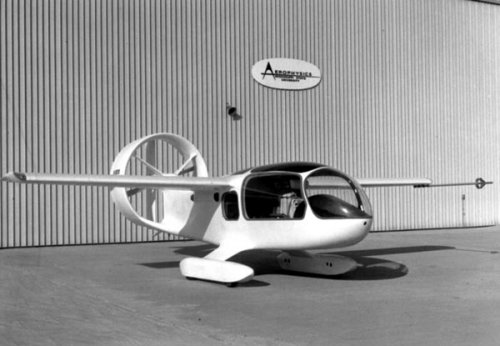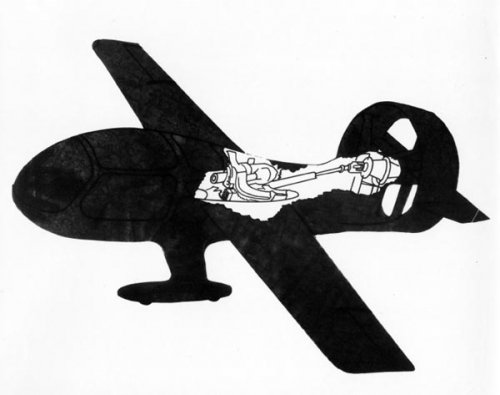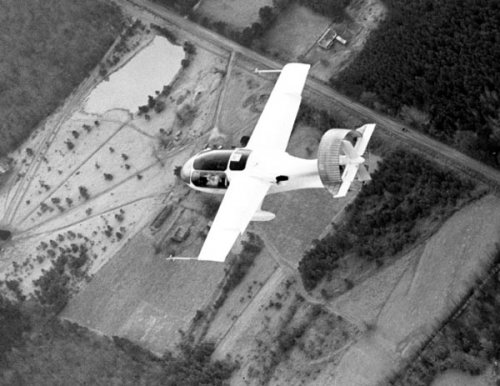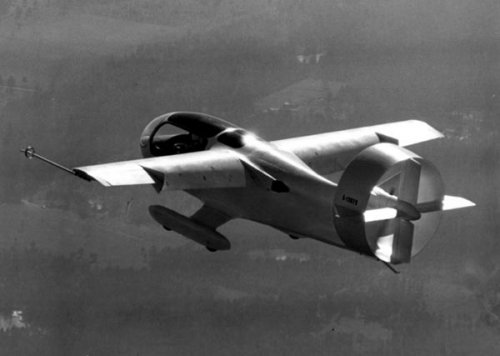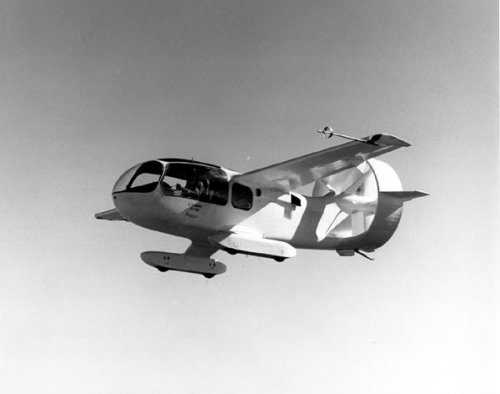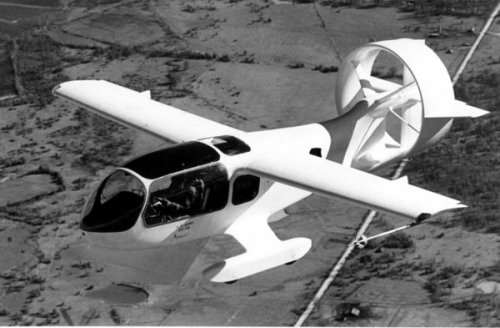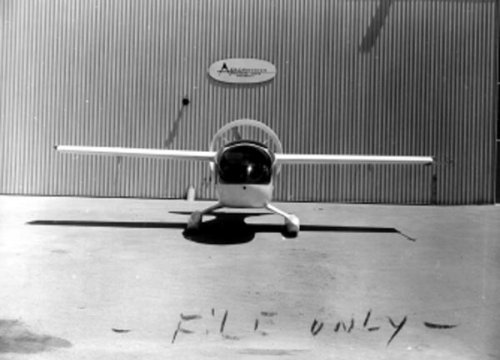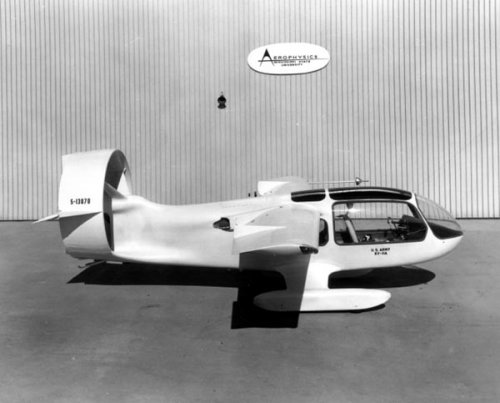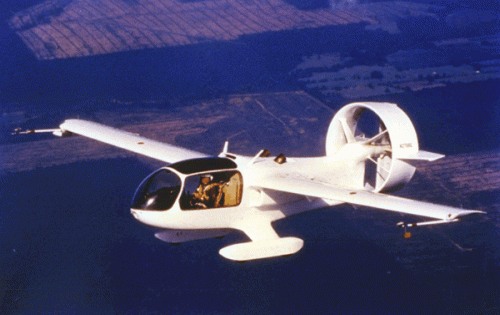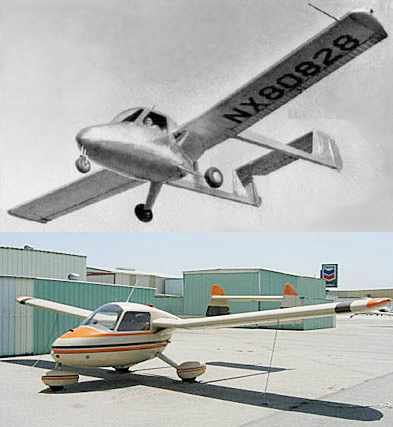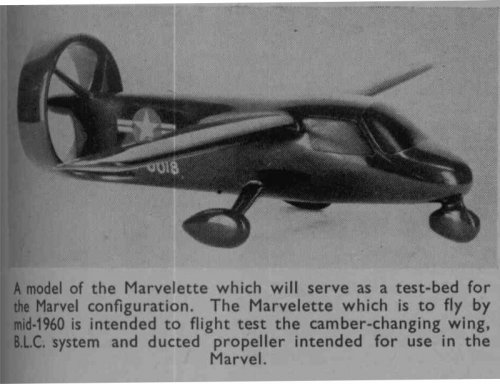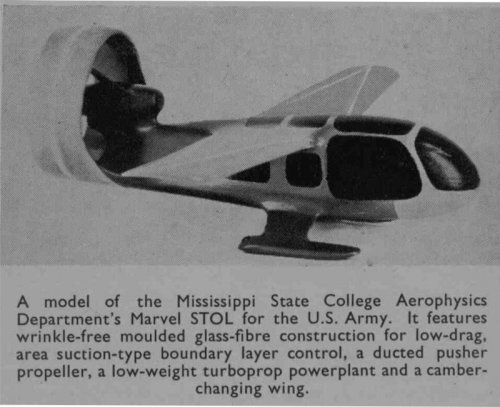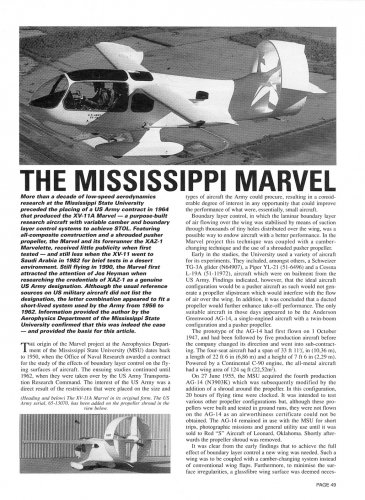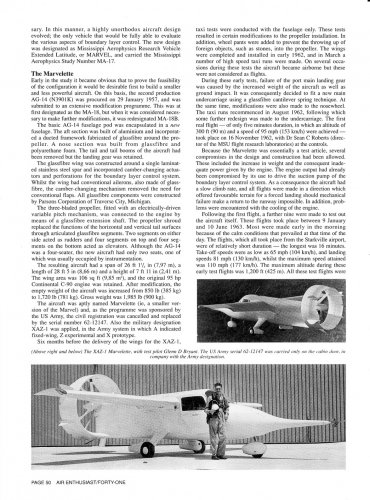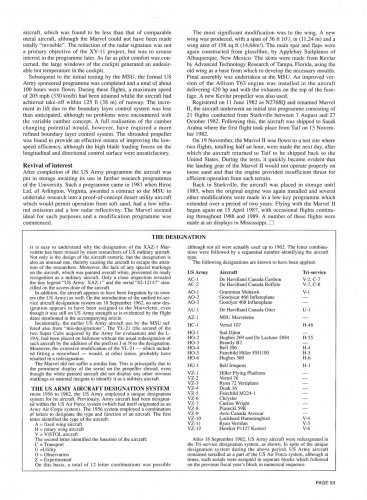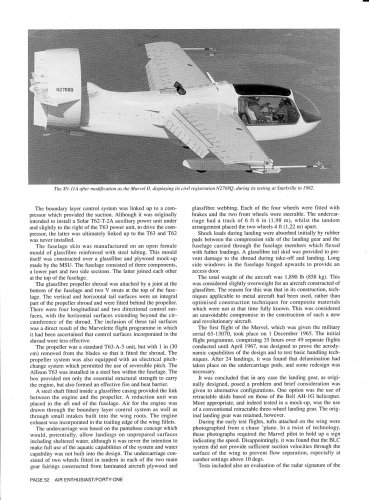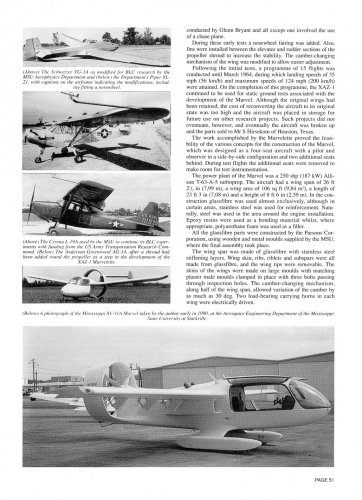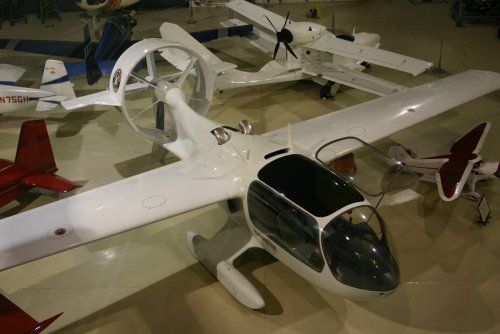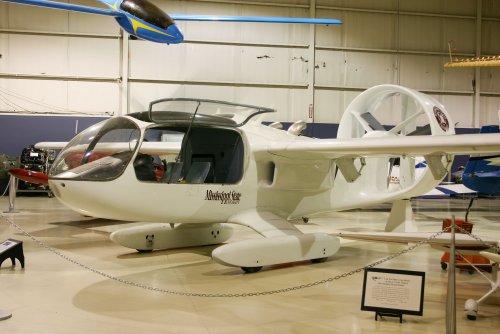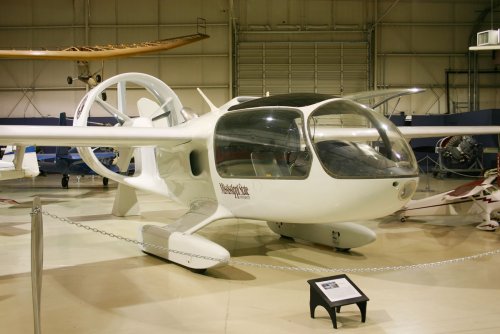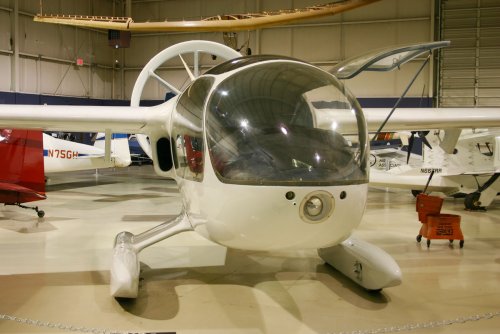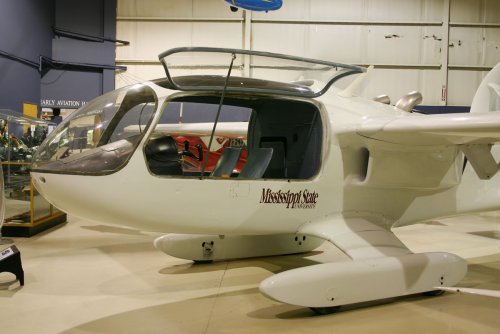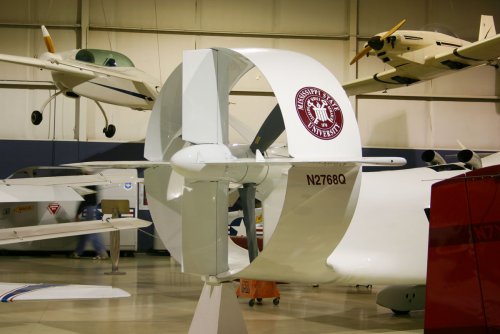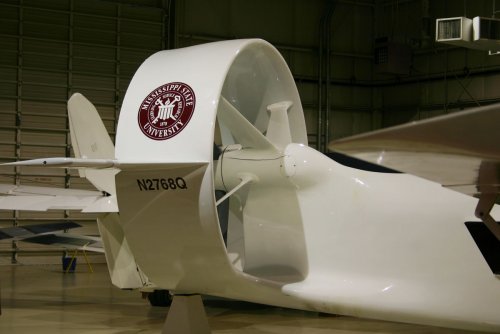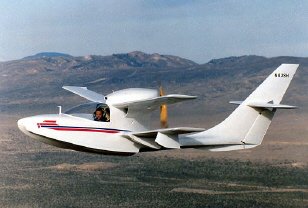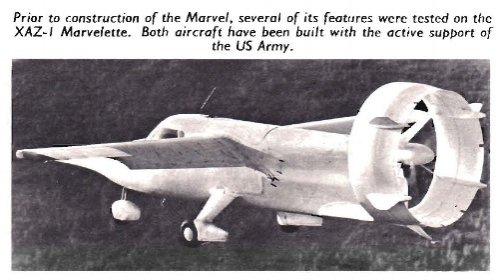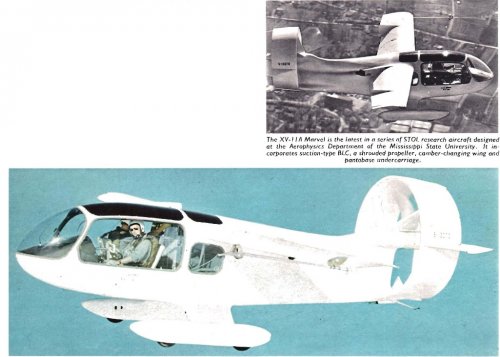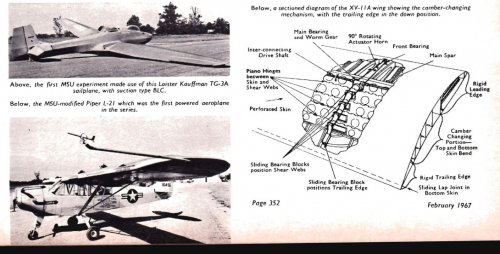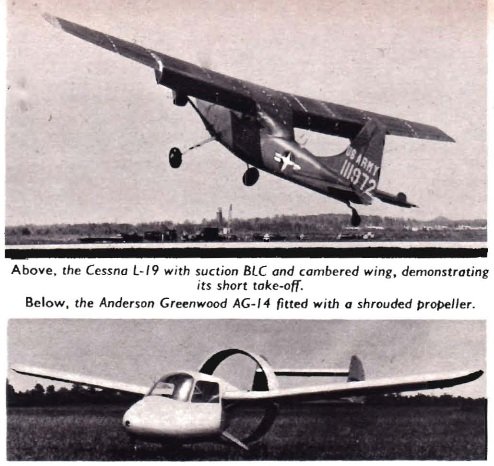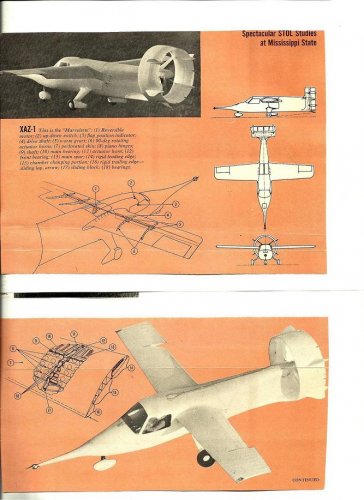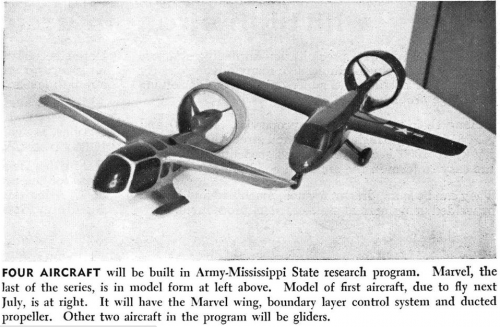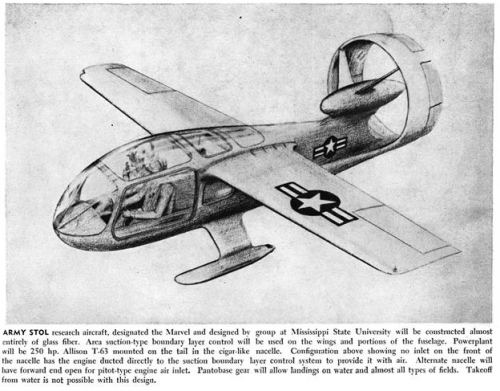STOL RESEARCH AT MISSISSIPPI UNIVERSITY
CULMINATING more than 12 years of research into boundary layer control by the Aerophysics Department of the Mississippi State University, the XV-11A Marvel has been under test since early 1966 and combines three separate aids to STOL performance suction type boundary layer control (BLC), thrust augmentation by ducted propeller and geometric BLC. All three systems had previously been tested on other research aircraft used in the programme. The XV-11A, which as the Army designation indicates is partially financed by Government funds, has a theoretical speed range of 7.25:1 and a maximum lift coefficient of 4.5. It was built for the University by Parsons Corporation of Traverse City, Michigan, and has several features in common with the earlier XAZ-1 Marvelette (described below), including the wing: this has a distributed suction BLC system plus geometric BLC and includes a camber-changing mechanism which varies the angle of the entire trailing edge in place of normal flaps. Longitudinal members in the wings are joined to the top and bottom aerofoil surfaces with piano hinges to allow movement of the structural members relative to the skin. Construction of the wing, like the remainder of the structure of the XV-11A, is of glass-fibre, providing a smooth. wave-free finish. Propulsion comes from a 250 hp Allison T63 turbo shaft engine driving the pusher propeller through a 3: I reduction gearbox, providing a maximum of 2,075 rpm on the propeller shaft. There is no air intake, in the normal sense, to the engine: its air supply is by way of more than one million tiny holes drilled in the surface of the wings and part of the fuselage for the suction BLC system, and there is no auxiliary equipment between the engine compressor intake and these holes. The steel propeller shaft is supported by five bearings and enclosed in a glass-fibre housing through which oil is pumped. A shroud round the propeller is used to augment its thrust, the object being to accelerate the aircraft to maximum flying speed in the shortest possible time. Design static thrust of the shrouded propeller is 1,300 Ib (590 kg) giving the XV-IIA a theoretical take-off run of 122 ft. (37,18 m) at a lift coefficient of 4.5. As first tested the XV-Il A has a "pantobase" landing gear intended to permit operation from very soft ground into which wheels alone would sink. The pantobase fairings would also support the aircraft on water at speeds down to 15 mph (24 km/h) but the drag penalty for this installation is high and a retractable undercarriage is being studied for possible future use. The Marvel has a maximum design level speed of 205 mph (330 km/h) and climbs at 1,760 ft./min (9 m/sec) at 68 mph (109 km/h). Empty and gross weights are 1,600 Ib (725 kg) and 2,400,lb (I 090 kg) respectively. The span is 26 ft. 2 in (7,96 m), overall length, 23 ft. 5 in (7,14 m), height, 8 ft. 9 in (2.67 m), wing area, 106 sq. ft. (9,85 m') and aspect ratio 6.5.ller is J,300 Ib (590 kg) giving the XV-11A a theoretical take-off run of 122 ft. (37,18 m) at a lift coefficient of 4.5. As first tested the XV-Il A has a "pantobase" landing gear intended to permit operation from very soft ground into which wheels alone would sink. The pantobase fairings would also support the aircraft on water at speeds down to 15 mph (24 km/h) but the drag penalty for this installation is high and a retractable undercarriage is being studied for possible future use. The Marvel has a maximum design level speed of 205 mph (330 km/h) and climbs at 1,760 ft. /min (9 m/sec) at 68 mph (109 km/h). Empty and gross weights are 1,600 Ib (725 kg) and 2,400,lb. (I 090 kg) respectively. The span is 26 ft. 2 in (7,96 m), overall length, 23 ft. 5 in (7,14 m), height, 8 ft. 9 in (2.67 m), wing area, 106 sq. ft. (9,85 m') and aspect ratio 6.5.
EARLIER RESEARCH
Work began in the Aerophysics Department of the Mississippi State University in 1953 to develop a suction boundary layer control system for fixed wing aircraft which would improve the lift coefficient of the wing: the use of thrust augmentation and geometric boundary layer control to increase the potential speed range of the aircraft were later additions to the programme. Tests indicated that mechanical devices such as flaps, slots, etc. could attain maximum lift coefficients of only about 3.0, whereas high-lift BLC systems demonstrated much higher values. A so-called distributed suction system employing use of suction through perforations distributed in the upper surface of the aerofoil was applied to a TG-3 sailplane. Holes of .020-.030 inch diameter, were drilled ten per inch (approximately 600,000 holes total) and suction obtained via two axial flow pumps installed at the wing roots. The max lift coefficient of the TG-3's unflapped wing was thus increased from 1.4 to 2.1.
The next hardware test was with a modified Piper L-21 with a similar BLC system. but in this case the suction air was passed along the inside of the wing, through a double windshield and was used to cool the engine so that additional cooling air was not required and the intakes could he sealed. The pumps were mechanically linked to the engine with the result that full BLC was available for take-off at high rpm but not for landing with the engine throttled back. This made the craft unsuitable for STOL performance hut demonstrated that lift coefficients of 4.2 could be obtained with the expenditure of about 10 hp from the engine. This L-21 was fitted with a tricycle undercarriage incorporating a spring type main gear and weighed 1.350 lb (612 kg). With the BLC system it obtained a 42 per cent reduction in take-off distance over a 50 ft. (15,2 m) obstacle, could fly at a true airspeed of 35 mph (56 km/h) under complete control. and accomplished a new stall speed of 28 mph (45 km/h). Powerplant was a 125 hp Lycoming, less 8-10 hp with "BLC in operation. A modified Cessna L-19 Bird Dog was the third aircraft used III the MSU research programme. A BLC system similar to those of the TG-3 and L-21 was again installed, but with modifications suggested by the previous research. Two hydraulically driven axial flow pumps were fitted. one under each wing and powered by a hydraulic pump at the main engine. Each pump had a 9 in 1228.(, mm) diameter fan and the wing had some 700.000 holes drilled into it. In this case. the BLC could also be varied independently of the engine speed.. thereby making the system suitable for both take-of'- and landing. Tail area was also increased and vertical plates added for improved directional control at low forward speeds. The flaps were modified to eliminate the slot and the sharp geometric discontinuity associated with them. The leading edge radius of the wing was also increased from 1.25 in (J 1,7 mm) to 1.8 in (45,7 mm) to reduce centrifugal forces and maintain attached boundary flow. The modified L-19 had a minimum flying speed of 31 mph (50 km/h) at 2,300 lb (1043 kg) gross weight. But still retained the cruise speed of the conventional configuration. It has a resulting lift coefficient of 5.1 with the expenditure of 12 hp from the main 213 hp Continental engine. The next programme was concerned with thrust augmentation. Open propellers lacked efficiency at low forward speeds. whereas a shroud provided a considerable increase in the thrust of the propeller, and thus helped acceleration and take-off performance. One of the few Anderson-Greenwood AG-14 twin-boom pusher aircraft was used to demonstrate the effectiveness of the shrouded propeller principle. The propeller was modified to account for the change in inflow velocities TO the propeller but the results indicated that with the same 90 hp Continental and the same thrust loading on a propeller, the static thrust was increased from 275 lb. (125 kg) to 540 Ib (245 kg) due to the action of the shroud. A glass-fibre wing with variable camber instead of flaps was likewise fitted to the AG-14. High cruise speed through geometric boundary layer control was demonstrated through research on a Navion L-17B and a Beech L-23. With the four-seat L.-17B, range was increased from 590 miles (950 km) to I.OID miles (I 625 km) with average fuel consumption increased only to 17 mpg. Max cruise speed was also increased from 120 kts (222 km/h) to 132 kts (244 km/h). All this was accomplished by removing all external radio antennae and placing them in glass-fibre low-drag Hoerner wing tips. The wings were covered with a celastic material to cover the rivet heads and smooth the leading edge back to the 60 per cent chord position. Cabin windows were made flush. door handles removed and glass-fibre wing root fillets added. The engine cowling was modified so that the engine was cooled with a minimum pressure drop. The L-23 was similarly modified but landing gear doors were added and jet-ejection exhaust installed. The result of these modifications was that the power required to fly at 180 mph (290 km/h) was reduced from 410 to 310 hp, and the safe single-engine airspeed was reduced to below the stall speed of the conventional configuration. The next stage of the development programme was to see if the three types of system-the low drag, the thrust augmentation, and the high lift BLC systems could be incorporated in a single aeroplane-and thus the XAZ-I Marvelette was born. It had the variable camber wing of glass-fibre construction, incorporating perforated surface and suction pumps; the large shrouded propeller at the tail with the elevator and rudder controls incorporated in the shroud to further decrease drag; and a glass fibre tricycle landing gear. Large fillets were added at the shroud fuselage intersections, at the wing root positions and at the junction of the landing gear and the fuselage to ensure wave-free, smooth surfaces for low drag. The Marvelette. which first flew in March 1962, was not intended as a true STOL aeroplane as it was only powered by a 90 hp Continental with 10 hp being taken up by the BLC system; therefore a low rate of climb considerably hindered the flight test programme on the over-weight aircraft. Original design max speed was 200 mph 1322 kill/h) but only about 125 mph (201 km/h) was actually achieved. Max cruise was 115 mph (185 km/h) and landing about 35 mph (56 km/h). -HOWARD LEVY

